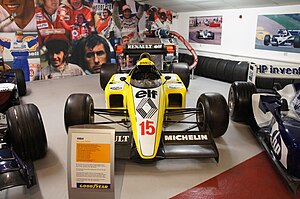Renault RE50
 |
|||||||||
| Category | Formula One | ||||||||
|---|---|---|---|---|---|---|---|---|---|
| Constructor | Renault | ||||||||
| Designer(s) | Michel Tétu Bernard Dudot |
||||||||
| Predecessor | RE40 | ||||||||
| Successor | RE60 | ||||||||
| Technical specifications | |||||||||
| Chassis | Carbon fibre monocoque | ||||||||
| Suspension (front) | Forks / spring / delta | ||||||||
| Suspension (rear) | Forks / spring / delta | ||||||||
| Axle track | Front: 1,802 mm (70.9 in) Rear: 1,670 mm (66 in) |
||||||||
| Wheelbase | 2,680 mm (105.5 in) | ||||||||
| Engine | Renault Gordini EF4, 1,492 cc (91.0 cu in), 90° V6, turbo, mid-engine, longitudinally mounted | ||||||||
| Transmission | Hewland, with Renault casing 5-speed manual | ||||||||
| Weight | 540 kg (1,190.5 lb) | ||||||||
| Fuel | Elf | ||||||||
| Tyres | Michelin | ||||||||
| Competition history | |||||||||
| Notable entrants | Equipe Renault Elf | ||||||||
| Notable drivers | 15. 16. 33. |
||||||||
| Debut | 1984 Brazilian Grand Prix | ||||||||
|
|||||||||
| Constructors' Championships | 0 | ||||||||
| Drivers' Championships | 0 | ||||||||
The Renault RE50 was a Formula One car raced by the Renault team in the 1984 season. The car was driven by Frenchman Patrick Tambay, who joined the team from Ferrari, and Englishman Derek Warwick, who had joined the team after 3 seasons with Toleman. The best results were 3 second-place and 2 third-place finishes, making it the first factory Renault not to win a Grand Prix in a season since the RS01 in 1978.
The car was expected to be as competitive in the hands of two-time Grands Prix winner Tambay and the highly rated Warwick as the RE40 had been when driven by Alain Prost to four wins in 1983. While the car was quick straight out of the box, it had a few problems that the team and drivers could not overcome. The Renault EF4 turbo engine was said to be powerful at 800 bhp (597 kW; 811 PS) but usually proved too thirsty for either driver to challenge for more than 2nd or 3rd place at most races. This proved to be the same problem for other Renault engined cars such as the Lotus 95T (which was designed by former Renault designer Gérard Ducarouge who had joined Lotus in 1984). In 1984 Formula One cars were restricted to a maximum of 220 litres of fuel per race with the re-fueling of 1983 now banned and the French team never got on top of that problem despite a new and exciting (for 1984) electronic fuel monitoring device. The other main problem was that the car's tub which was somewhat fragile, despite being made of carbon fibre which was stronger than the traditional aluminium. This fragility saw Warwick injuring his legs in crashes at both Dijon and Monaco, while Tambay suffered a broken left leg after crashing into Warwick's already crashed car at the first corner of the race in Monaco. Both drivers were injured as a result of their cars suspension arms punching through the carbon fibre monocoque.
...
Wikipedia
